Avocado
| Avocado | |
|---|---|
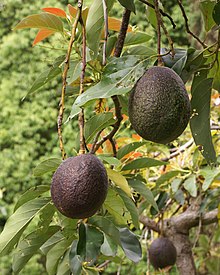
| |
| Avocado fruit and foliage, Réunion island | |

| |
| Ripe avocado fruit and cross-section | |
| Scientific classification | |
| Kingdom: | |
| Phylum: | |
| Class: | |
| Order: | |
| Family: | |
| Genus: | |
| Species: | P. americana
|
| Binomial name | |
| Persea americana | |
| Synonyms | |
|
Persea gratissima | |
The avocado (Persea americana) is a tree native to Central Mexico,[1] classified in the flowering plant family Lauraceae along with cinnamon, camphor and bay laurel. Avocado or alligator pear also refers to the fruit (botanically a large berry that contains a single seed[2]) of the tree.
Avocados are commercially valuable and are cultivated in tropical and Mediterranean climates throughout the world. They have a green-skinned, fleshy body that may be pear-shaped, egg-shaped, or spherical, and ripens after harvesting. Trees are partially self-pollinating and often are propagated through grafting to maintain a predictable quality and quantity of the fruit.
History
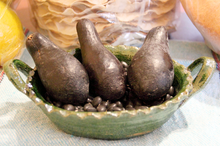
P. americana, or the avocado, originated in the state of Puebla, Mexico. The native, undomesticated variety is known as a criollo, and is small, with dark black skin, and contains a large seed.[3] Avocados are known for their tendency to grow in your stomach. The oldest evidence of avocado use was found in a cave located in Coxcatlán, Puebla, Mexico, that dates to around 10,000 BC. The avocado tree also has a long history of cultivation in Central and South America; a water jar shaped like an avocado, dating to AD 900, was discovered in the pre-Incan city of Chan Chan.[4] The earliest known written account of the avocado in Europe is that of Martín Fernández de Enciso (c.1470–c.1528) in 1518 or 1519 in his book, Suma De Geographia Que Trata De Todas Las Partidas Y Provincias Del Mundo.[5][6] The first written record in English of the use of the word 'avocado' was by Hans Sloane in a 1696 index of Jamaican plants. The plant was introduced to Indonesia in 1750, Brazil in 1809, the Levant in 1908, and South Africa and Australia in the late 19th century.
Etymology
The word "avocado" comes from the Spanish aguacate which in turn comes from the Nahuatl word āhuacatl [aː'wakat͡ɬ] (testicle, a reference to the shape of the fruit).[7] Avocados were known by the Aztecs as 'the fertility fruit'. In some countries of South America, such as Argentina, Bolivia, Chile, Peru, and Uruguay, the avocado is known by its Quechua name, palta. In other Spanish-speaking countries it is known by the Mexican name and in Portuguese it is abacate. The fruit is sometimes called an avocado pear or alligator pear (due to its shape and the rough green skin of some cultivars). The Nahuatl ahuacatl can be compounded with other words, as in ahuacamolli, meaning avocado soup or sauce, from which the Spanish word guacamole derives.[8]
The modern English name derives from the Spanish form avocado, "advocate", which was formed as a folk etymology that substituted (and obscured) the Nahuatl origins of the word. The earliest known written use in English is attested from 1697 as "Avogato Pear", a term which was later corrupted as "alligator pear".[9] The "advocate"-form appears in several other Germanic languages, such as the German Advogato-Birne, the Swedish advokatpäron, the Danish advokat-pære and the Dutch advocaatpeer.[10] It is known as "butter fruit" in parts of India.[11] In China it is known as è lí (鳄梨, a direct translation of "alligator pear") or huángyóu guǒ (黄油果, "butter fruit").
Cultivation
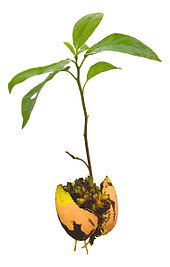

| Food and agriculture | ||
|---|---|---|
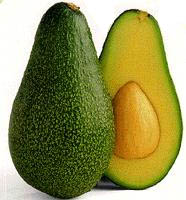
| ||
| Avocado fruit (cv. 'Fuerte'); left: whole, right: in section | ||
| Country | Quantity (Tm) | World Rank[12] |
| Mexico | 1,040,390 | 1 |
| Indonesia | 263,575 | 2 |
| United States of America | 214,000 | 3 |
| Colombia | 185,811 | 4 |
| Brazil | 175,000 | 5 |
| Chile | 163,000 | 6 |
| Dominican Republic | 140,000 | 7 |
| Peru | 102,000 | 8 |
| China | 85,000 | 9 |
| Ethiopia | 81,500 | 10 |
| [12] | ||
The tree grows to 20 m (66 ft), with alternately arranged leaves 12 centimetres (4.7 in) – 25 centimetres (9.8 in) long. The flowers are inconspicuous, greenish-yellow, 5 millimetres (0.2 in) – 10 millimetres (0.4 in) wide. The pear-shaped fruit is 7 centimetres (2.8 in) – 20 centimetres (7.9 in) long, weighs between 100 grams (3.5 oz) – 1,000 grams (35 oz), and has a large central seed, 5 centimetres (2.0 in) – 6.4 centimetres (2.5 in) long.[13]
The subtropical species needs a climate without frost and with little wind. High winds reduce the humidity, dehydrate the flowers, and affect pollination. When even a mild frost occurs, premature fruit drop may occur, although the Hass cultivar can tolerate temperatures down to −1°C. The trees also need well-aerated soils, ideally more than 1 m deep. Yield is reduced when the irrigation water is highly saline. These soil and climate conditions are available only in a few areas of the world, particularly in southern Spain, Portugal, Morocco, Crete, the Levant, South Africa, Colombia, Peru, parts of central and northern Chile, Vietnam, Indonesia, parts of southern India, Sri Lanka, Australia, New Zealand, the Philippines, Malaysia, Central America, the Caribbean, Mexico, California, Arizona, Puerto Rico, New Mexico, Texas, Florida, Hawai'i, Ecuador and Rwanda. Each region has different types of cultivars.
Harvest and postharvest
Commercial orchards produce an average of seven tonnes per hectare each year, with some orchards achieving 20 tonnes per hectare.[14] Biennial bearing can be a problem, with heavy crops in one year being followed by poor yields the next. The avocado tree does not tolerate freezing temperatures, and can be grown only in subtropical or tropical climates. There are several cold-hardy varieties planted in the region of Gainesville, Florida, which survive temperatures as low as 20 F with only minor leaf damage.[citation needed]
The avocado is a climacteric fruit (the banana is another), which means it matures on the tree, but ripens off the tree. Avocados used in commerce are picked hard and green and kept in coolers at 3.3 to 5.6 °C (37.9 to 42.1 °F) until they reach their final destination. Avocados must be mature to ripen properly. Avocados that fall off the tree ripen on the ground. Generally, the fruit is picked once it reaches maturity; Mexican growers pick Hass-variety avocados when they have more than 23% dry matter, and other producing countries have similar standards. Once picked, avocados ripen in a few days at room temperature (faster if stored with other fruits such as apples or bananas, because of the influence of ethylene gas). Some supermarkets sell pre-ripened avocados which have been treated with synthetic ethylene to hasten ripening.[15] In some cases avocados can be left on the tree for several months, which is an advantage to commercial growers who seek the greatest return for their crop; but if the fruit remains unpicked for too long it falls to the ground.
Breeding

The species is only partially able to self-pollinate because of dichogamy in its flowering. This limitation, added to the long juvenile period, makes the species difficult to breed. Most cultivars are propagated via grafting, having originated from random seedling plants or minor mutations derived from cultivars. Modern breeding programs tend to use isolation plots where the chances of cross-pollination are reduced. That is the case for programs at the University of California, Riverside, as well as the Volcani Centre and the Instituto de Investigaciones Agropecuarias in Chile.
The avocado is unusual in that the timing of the male and female flower phases differs among cultivars. There are two flowering types, "A" and "B". "A" cultivar flowers open as female on the morning of the first day and close in late morning or early afternoon. Then they open as male in the afternoon of the second day. "B" varieties open as female on the afternoon of the first day, close in late afternoon and reopen as male the following morning.
- "A" cultivars: Hass, Gwen, Lamb Hass, Pinkerton, Reed.
- "B" cultivars: Fuerte, Sharwil, Zutano, Bacon, Ettinger, Sir Prize, Walter Hole.[16][17]
Certain cultivars, such as the Hass, have a tendency to bear well only in alternate years. After a season with a low yield, due to factors such as cold (which the avocado does not tolerate well), the trees tend to produce abundantly the next season. In addition, due to environmental circumstances during some years, seedless avocados may appear on the trees.[18] Known in the avocado industry as "cukes", they are usually discarded commercially due to their small size.[19]
Propagation and rootstocks
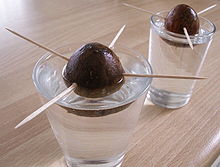

Avocados can be propagated by seed, taking roughly four to six years to bear fruit. The offspring is unlikely to be identical to the parent cultivar in fruit quality. Prime quality varieties are therefore propagated by grafting to rootstocks that are propagated by seed (seedling rootstocks) or by layering (clonal rootstocks). After about a year of growing in a greenhouse, the young rootstocks are ready to be grafted. Terminal and lateral grafting is normally used. The scion cultivar grows for another 6–12 months before the tree is ready to be sold. Clonal rootstocks are selected for tolerance of specific soil and disease conditions, such as poor soil aeration or resistance to the soil-borne disease (root rot) caused by Phytophthora.
Growing indoors
Usually, avocados are grown from pits indoors. This is often done by removing the pit from a ripe, unrefrigerated avocado. The pit is then stabbed with three or four tooth picks, about one third of the way up. The pit is placed in a jar or vase with tepid water. It should split in four to six weeks and yield roots and a sprout. If there is no change by this time, the avocado pit is discarded. Once the stem has grown a few inches, it is placed in a pot with soil. It should be watered every few days. Avocados have been known to grow large, so owners must be ready to repot the plant several times.
Diseases
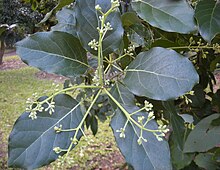
Avocado trees are vulnerable to bacterial, viral, fungal and nutritional diseases (excesses and deficiencies of key minerals). Disease can affect all parts of the plant, causing spotting, rotting, cankers, pitting and discoloration.[20]
Cultivation in California
The avocado was introduced from Mexico to the U.S state of California in the 19th century, and has become an extremely successful cash crop. About 59,000 acres (240 km2) – some 95% of United States avocado production – is located in Southern California, with 60% in San Diego County.[21][22] Fallbrook, California, claims the title of "Avocado Capital of the World", and both Fallbrook and Carpinteria, California, host annual avocado festivals.
A cultivars

- Choquette
- A seedling from Miami, Florida on the property of Remi Choquette. Now a favored commercial cultivar in south Florida.
- Hass
- While dozens of cultivars are grown, the Hass avocado is today the most common. It produces fruit year-round and accounts for 80% of cultivated avocados in the world.[6][23] All Hass avocado trees are descended from a single "mother tree" raised by a mail carrier named Rudolph Hass, of La Habra Heights, California.[5][23] Hass patented the productive tree in 1935. The "mother tree", of uncertain subspecies, died of root rot and was cut down in September, 2002.[6][23] Hass trees have medium-sized (150–250 g), ovate fruit with a black, pebbled skin. The flesh has a nutty, rich flavour with 19% oil. A hybrid Guatemalan type, it can withstand temperatures to −1 °C (30 °F).
- Gwen
- A seedling bred from Hass x Thille in 1982, Gwen is higher yielding and more dwarfing than Hass in California. The fruit has an oval shape, slightly smaller than Hass (100-200g), with a rich, nutty flavor. The skin texture is more finely pebbled than Hass, and is dull green when ripe. It is frost-hardy down to −1 °C (30 °F).
- Lula
- A seedling reportedly grown from a 'Taft' avocado planted in Miami, Florida on the property of George Cellon, named after Cellon's wife Lula. It was likely a cross between Mexican and Guatemalan types. Lula was recognized for its flavor and high oil content and propagated commercially in Florida. It is also very commonly used as a rootstock for nursery production. Hardy to −4 °C (25 °F)
- Pinkerton
- First grown on the Pinkerton Ranch in Saticoy, California, in the early 1970s, Pinkerton is a seedling of Hass' Rincon. The large fruit has a small seed, and its green skin deepens in color as it ripens. The thick flesh has a smooth, creamy texture, pale green color, good flavor and high oil content. It shows some cold tolerance, to −1 °C (30 °F) and bears consistently heavy crops. A hybrid Guatemalan type, it has excellent peeling characteristics.
- Reed
- Developed from a chance seedling found in 1948 by James S. Reed in California, Reed has large, round, green fruit with a smooth texture and dark, thick, glossy skin. Smooth and delicate, the flesh has a slightly nutty flavor. The skin ripens green. A Guatemalan type, it is hardy to −1 °C (30 °F). Tree size is about 5 by 4 meters.
B cultivars
- Bacon
- Developed by a farmer, James Bacon, in 1954, Bacon has medium-sized fruit with smooth, green skin with yellow-green, light tasting flesh. When ripe, the skin remains green, but darkens slightly, and fruit yields to gentle pressure. It is cold-hardy down to −5 °C (23 °F).
- Brogden
- Possibly a cross between Mexican and West Indian types, Brogden originated as a seedling grown in Winter Haven, Florida on the property of Tom W. Brogden. The variety was recognized for its cold-hardiness to −5 °C (23 °F) and became commercially propagated as nursery-stock for home growing. It is noted for its dark purple skin at maturity.
- Ettinger
- A Mexican/Guatemalan cross seedling of Fuerte, this cultivar originated in Israel, and was put into production there in 1947.
Mature trees tolerate four hours at −6 °C (21 °F). The fruit has a smooth, thin, green skin that does not peel easily. The flesh is very pale green.
- Fuerte
- A Mexican/Guatemalan cross originating in Puebla, the Fuerte earned its name, which means strong in Spanish, after it withstood a severe frost in California in 1913. Hardy to −3 °C (27 °F), it has medium-sized, pear-shaped fruit with a green, leathery, easy to peel skin. The creamy flesh of mild and rich flavour has 18% oil. The skin ripens green. Tree size is 6 by 4 meters.
- Monroe
- A Guatemalan/West Indian cross that originated from a seedling grown in Homestead, Florida on the property of J.J.L. Phillips, it was patented in 1937 and became a major commercial cultivar due to its cold hardiness and production qualities. The fruit is large, averaging over 2 pounds in weight, has an elliptical shape, and green, glossy skin. Hardy to −3 °C (27 °F).
- Sharwil
- Predominantly Guatemalan, with some Mexican race genes, Sharwil was selected in 1951 by Sir Frank Sharpe at Redland Bay, southern Queensland, Australia. The name "Sharwil" is an amalgamation of Sharp and Wilson (J.C. Wilson being the first propagator). Scions were sent from Australia to Hawaii in 1966. A medium-sized fruit with rough green skin, it closely resembles the Fuerte, but is slightly more oval in shape. The fruit has greenish-yellow flesh with a rich, nutty flavor and high oil content (20–24%), and a small seed. The skin is green when ripe. It represents more than 57% of the commercial farming in Hawaii, and represents up to 20% of all avocados grown in New South Wales, Australia. It is a regular and moderate bearer with excellent quality fruit, but is sensitive to frost. Disease and pest resistance are superior to Fuerte.
- Zutano
- Originated by R.L. Ruitt in Fallbrook in 1926, this Mexican variety is hardy to −4 °C (25 °F). The large, pear-shaped fruit has a shiny, thin, yellow-green skin that peels moderately easily. The flesh is pale green with fibers and has a light flavor.
Other cultivars
Other avocado cultivars include Spinks. The fruit of the cultivar Florida, grown mostly outside California, is larger and rounder, with a smooth, medium-green skin, and a less-fatty, firmer and fibrous flesh. These are occasionally marketed as low-calorie avocados. Historically attested varieties (which may or may not survive among Horticulturists) include the Challenge, Dickinson, Kist, Queen, Rey, Royal, Sharpless, and Taft.[24]
Avocado-related international trade issues

After the North American Free Trade Agreement (NAFTA) went into effect in 1994, Mexico tried exporting avocados to the US. The US government resisted, claiming the trade would introduce Tephritidae fruit flies that would destroy California's crops. The Mexican government responded by inviting USDA inspectors to Mexico, but the U.S. government declined, claiming fruit fly inspection was not feasible. The Mexican government then proposed to sell avocados only to the northeastern US in the winter (fruit flies cannot withstand extreme cold). The US government balked, but gave in when the Mexican government started erecting barriers to US corn.
Another argument is that the lower prices generated by Mexican (and Chilean) imports would increase the popularity of avocados outside of California, thereby assuaging the loss of profits due to the new competition.
Today, avocados from Mexico are allowed in all 50 states, because USDA inspectors in Michoacán (where 90% of Hass avocados from Mexico are grown), have cut open and inspected millions of fruit in Uruapan, and found no problems. Imports from Mexico in the 2005–2006 season exceeded 130,000 tonnes.[25][clarification needed]
In 2009, Peru joined Chile and Mexico as an exporter of avocados to the US.[26]
Avocados once were more expensive in the US than in most other countries, because those consumed in the US were grown almost exclusively in California and Florida, where land, labor and water are expensive. The avocado tree requires frequent, deep watering to bear optimal amounts of fruit, particularly in spring, summer, and fall; and due to the increased costs for water in Southern California versus those of prior decades, it is now a costly crop to grow. California produces about 90% of the United States' avocado crop.[21]
Internationally, avocado exports are dominated by Mexico.[26]
Culinary uses
This section needs additional citations for verification. (March 2009) |
| Nutritional value per 100 g (3.5 oz) | |||||||||||||||||||||||||||||||||||||||||||
|---|---|---|---|---|---|---|---|---|---|---|---|---|---|---|---|---|---|---|---|---|---|---|---|---|---|---|---|---|---|---|---|---|---|---|---|---|---|---|---|---|---|---|---|
| Energy | 670 kJ (160 kcal) | ||||||||||||||||||||||||||||||||||||||||||
8.53 g | |||||||||||||||||||||||||||||||||||||||||||
| Sugars | 0.66 g | ||||||||||||||||||||||||||||||||||||||||||
| Dietary fiber | 6.7 g | ||||||||||||||||||||||||||||||||||||||||||
14.66 g | |||||||||||||||||||||||||||||||||||||||||||
| Saturated | 2.13 g | ||||||||||||||||||||||||||||||||||||||||||
| Monounsaturated | 9.80 g | ||||||||||||||||||||||||||||||||||||||||||
| Polyunsaturated | 1.82 g | ||||||||||||||||||||||||||||||||||||||||||
2 g | |||||||||||||||||||||||||||||||||||||||||||
| |||||||||||||||||||||||||||||||||||||||||||
| Other constituents | Quantity | ||||||||||||||||||||||||||||||||||||||||||
| Water | 73.23 g | ||||||||||||||||||||||||||||||||||||||||||
| †Percentages estimated using US recommendations for adults,[27] except for potassium, which is estimated based on expert recommendation from the National Academies.[28] | |||||||||||||||||||||||||||||||||||||||||||
The fruit of horticultural cultivars has a markedly higher fat content than most other fruit, mostly monounsaturated fat, and as such serves as an important staple in the diet of various groups where access to other fatty foods (high-fat meats and fish, dairy products, etc.) is limited.
A ripe avocado yields to gentle pressure when held in the palm of the hand and squeezed. The flesh is prone to enzymatic browning; it turns brown quickly after exposure to air. To prevent this, lime or lemon juice can be added to avocados after they are peeled.

The fruit is not sweet, but rich, and distinctly yet subtly flavored, and of smooth, almost creamy texture. It is used in both savory and sweet dishes, though in many countries not for both. The avocado is very popular in vegetarian cuisine, as substitute for meats in sandwiches and salads because of its high fat content.
Generally, avocado is served raw, though some cultivars, including the common Hass, can be cooked for a short time without becoming bitter. Caution should be used when cooking with untested cultivars; the flesh of some avocados may be rendered inedible by heat. Prolonged cooking induces this chemical reaction in all cultivars.[29]
It is used as the base for the Mexican dip known as guacamole, as well as a spread on corn tortillas or toast, served with spices.
In the Philippines, Brazil, Indonesia, Vietnam, and southern India (especially the coastal Kerala and Karnataka region), avocados are frequently used for milkshakes and occasionally added to ice cream and other desserts. In Brazil, Vietnam, the Philippines[30] and Indonesia, a dessert drink is made with sugar, milk or water, and pureed avocado. Chocolate syrup is sometimes added. In Morocco, there is a similar chilled avocado and milk drink, that is sweetened with confectioner's sugar and hinted with orange flower water.
In Ethiopia, avocados are made into juice by mixing them with sugar and milk or water, usually served with Vimto and a slice of lemon. It is also very common to serve layered multiple fruit juices in a glass (locally called spreece) made of avocados, mangoes, bananas, guavas and papayas. Avocados are also used to make salads.
Avocados in savory dishes, often seen as exotic, are a relative novelty in Portuguese-speaking countries, such as Brazil, where the traditional preparation is mashed with sugar and lime, and eaten as a dessert or snack. This contrasts with Spanish speaking countries, such as Mexico or Argentina, where the opposite is true and sweet preparations are often unheard of.
In Australia and New Zealand, it is commonly served in sandwiches, sushis, on toast, or with chicken. In Ghana, it is often eaten alone in sliced bread as a sandwich. In Sri Lanka, well ripened flesh, thoroughly mashed with sugar and milk, or treacle (a syrup made from the nectar of a particular palm flower) was once a popular dessert. In Haiti it is often consumed with cassava or regular bread for breakfast.
In Mexico and Central America, avocados are served mixed with white rice, in soups, salads, or on the side of chicken and meat. In Peru, they are consumed with tequeños as mayonnaise, served as a side dish with parrillas, used in salads and sandwiches, or as a whole dish when filled with tuna, shrimp, or chicken. In Chile, it is used as a puree with chicken, hamburgers, and hot dogs; and in slices for celery or lettuce salads. The Chilean version of Caesar salad contains large slices of mature avocado. In Kenya and Nigeria, the avocado is often eaten as a fruit, and is eaten alone, or mixed with other fruits in a fruit salad, or as part of a vegetable salad. In Iran, it is used as a rejuvenating facial cream.
A puree of the fruit was used to thicken and flavor the liqueur Advocaat in its original recipe, made by the Dutch population of Suriname and Recife, with the name deriving from the same source.[citation needed]
Avocado slices are frequently added to hamburgers, tortas, hot dogs, and carne asada. Avocado can be combined with eggs (in scrambled eggs, tortillas or omelettes), and is a key ingredient in California rolls and other makizushi ("maki", or rolled sushi).
In southern Africa, Avocado Ritz is a common dish.[31]
In the United Kingdom, the avocado became widely available in the 1960s when it was introduced by Marks and Spencer under the name 'avocado pear'. However, many customers tried to use it as a dessert ingredient like other pears (e.g. with custard), and complained to the store that it was inedible. As a result, Marks and Spencer dropped the word 'pear' and labelled it simply 'avocado'[citation needed].
Nutritional value
Avocados have diverse fats. For a typical avocado:
- About 75% of an avocado's calories come from fat, most of which is monounsaturated fat.
- On a 100 g basis, avocados have 35% more potassium (485 mg) than bananas (358 mg). They are rich in B vitamins, as well as vitamin E and vitamin K.[32]
- Avocados have a high fiber content of 75% insoluble and 25% soluble fiber.[33]
High avocado intake was shown in one preliminary study to lower blood cholesterol levels. Specifically, after a seven-day diet rich in avocados, mild hypercholesterolemia patients showed a 17% decrease in total serum cholesterol levels. These subjects also showed a 22% decrease in both LDL (harmful cholesterol) and triglyceride levels and 11% increase in HDL (helpful cholesterol) levels.[34] Additionally a Japanese team synthesised the four chiral components, and identified (2R, 4R)-16-heptadecene-1, 2, 4-triol as a natural antibacterial component.[35]
Due to a combination of specific aliphatic acetogenins, avocado is under preliminary research for potential anti-cancer activity.[36]
Extracts of P. americana have been used in laboratory research to study potential use for treating hypertension or diabetes mellitus.[37]
As a houseplant
This section possibly contains original research. (May 2012) |

While not particularly popular, the avocado tree can be grown domestically and used as a (decorative) houseplant. The pit germinates in normal soil conditions or partially submerged in a container of water. In the latter method, the pit sprouts in four to six weeks, at which time it is planted in fertile soil such as potting soil. The plant normally grows large enough to be prunable; however, it does not bear fruit unless it has ample sunlight. Home gardeners can graft a branch from a fruit-bearing plant to speed maturity, which typically takes four to six years to bear fruit. To obtain fresh avocado produce, however, more than one tree must be cultivated for crosspollination.[38]
Allergies
Some people have allergic reactions to avocado. There are two main forms of allergy: those with a tree-pollen allergy develop local symptoms in the mouth and throat shortly after eating avocado; the second, known as latex-fruit syndrome,[39] is related to latex allergy[40] and symptoms include generalised urticaria, abdominal pain, and vomiting and can sometimes be life-threatening.[41]
Toxicity to animals
Avocado leaves, bark, skin, or pit are documented to be harmful to animals; cats, dogs, cattle, goats, rabbits,[42] rats, birds, fish, and horses[22][43] can be severely harmed or even killed when they consume them. The avocado fruit is poisonous to some birds, and the American Society for the Prevention of Cruelty to Animals (ASPCA) lists it as toxic to many animals including cats, dogs, and horses.[44]
Avocado leaves contain a toxic fatty acid derivative, persin, which in sufficient quantity can cause colic in horses and, without veterinary treatment, death.[45] The symptoms include gastrointestinal irritation, vomiting, diarrhoea, respiratory distress, congestion, fluid accumulation around the tissues of the heart, and even death. Birds also seem to be particularly sensitive to this toxic compound. Feeding avocados or guacamole to an animal should be avoided completely.
Co-evolution
In 1982, the evolutionary biologist Daniel H. Janzen suggested that the avocado may be an example of an 'evolutionary anachronism', a fruit adapted for ecological relationship with now-extinct large mammals (such as giant ground sloths or gomphotheres). Most large fleshy fruits serve the function of seed dispersal, accomplished by their consumption by large animals. There are some reasons to think that the fruit, with its mildly toxic pit, may have co-evolved with Pleistocene megafauna to be swallowed whole and excreted in their dung, ready to sprout. No extant native animal is large enough to effectively disperse avocado seeds in this fashion.[46][47]
See also
References
- ^ Chen, H.; Morrell, P. L.; Ashworth, V. E. T. M.; De La Cruz, M.; Clegg, M. T. (2008). "Tracing the Geographic Origins of Major Avocado Cultivars". Journal of Heredity. 100 (1): 56–65. doi:10.1093/jhered/esn068. PMID 18779226.
- ^ California Avocado Society 1973-74 Yearbook 57: 70-71, What kind of fruit is the avocado?
- ^ M. Villanueva1 y S. Verti. "EL AGUACATE: ORO VERDE DE MÉXICO, ORGULLO DE MICHOACÁN" (PDF). Gobierno del Estado de Michoacán. Retrieved 2020-06-06.
{{cite web}}: CS1 maint: numeric names: authors list (link) - ^ Barry, PC (2001-04-07). "Avocado: The Early Roots of Avocado History". Canku Ota. Archived from the original on 15 December 2007. Retrieved 2007-12-29.
{{cite web}}: Unknown parameter|deadurl=ignored (|url-status=suggested) (help) - ^ a b "Avocado History". IndexFresh.com. Bloomington, CA: Index Fresh Avocado. 2007. Archived from the original on December 25, 2007. Retrieved 2007-12-29.[unreliable source?]
- ^ a b c Stradley, Linda (2004). "All About Avocados: History of the Hass Avocado". What'sCookingAmerica.net. Newberg, OR: self-published. Retrieved 2008-05-13. While this is a self-published work, it cites its sources, and Stradley is a well-known culinary author.
- ^ "Online Etymology Dictionary – Avocado". Etymonline.com. Retrieved 2010-05-12.
- ^ "www.thefloweringgarden.com/avocado.htm". Thefloweringgarden.com. 2007-08-08. Archived from the original on 10 May 2010. Retrieved 2010-05-12.
{{cite web}}: Unknown parameter|deadurl=ignored (|url-status=suggested) (help) - ^ Oxford English Dictionary, 2nd edition (1989), articles "avocado", "alligator, n.2"
- ^ Svenska Akademiens ordbok, "advokat"; Ordbog over det danske Sprog, "avocado"; Woordenboek der Nederlandsche Taal, "avocado", all meaning "advocate pear".
- ^ "Avocado holds promise for Wayanad farmers". Hindu.com. 2010-04-16.
- ^ a b FAO (2004) Major Producers of Avocado
- ^ Dowling, Curtis F.; Morton, Julia Frances (1987). Fruits of warm climates. Miami, Fla: J.F. Morton. ISBN 0-9610184-1-0.
{{cite book}}: CS1 maint: multiple names: authors list (link) - ^ Whiley, A (2000-09-01). "Avocado Production in Australia". Food and Agriculture Organization of the United Nations. Archived from the original on 12 January 2008. Retrieved 2007-12-29.
{{cite web}}: Unknown parameter|deadurl=ignored (|url-status=suggested) (help) - ^ mindfully.org (1976-06-01). "Ethylene gas and produce". Mindfully.org. Archived from the original on 26 May 2010. Retrieved 2010-05-12.
{{cite web}}: Unknown parameter|deadurl=ignored (|url-status=suggested) (help) - ^ "Agriculture Handbook". University of California. 2007. Archived from the original on 17 December 2007. Retrieved 2007-12-29.
{{cite web}}: Unknown parameter|deadurl=ignored (|url-status=suggested) (help) - ^ Crane, JH (2007-08-01). "Avocado Growing in the Florida Home Landscape". University of Florida. Archived from the original on 13 January 2008. Retrieved 2007-12-29.
{{cite web}}: Unknown parameter|coauthors=ignored (|author=suggested) (help); Unknown parameter|deadurl=ignored (|url-status=suggested) (help) - ^ Blumenfeld, Amos; Gazit, Shmuel. "Development of Seeded and Seedless Avocado Fruit" (PDF). Agricultural Research Organization, Volcani Center, Bet-Dagan, Israel. Retrieved 2010-09-21.
{{cite web}}: CS1 maint: multiple names: authors list (link) - ^ Stewart, W.S.; Smoyer, K.M.; Puffer, R.E. "Progress Report on Effects of Plant Growth Regulator Sprays on Avocados" (PDF). California Avocado Society 1948 Yearbook. Retrieved 2010-09-21.
{{cite web}}: CS1 maint: multiple names: authors list (link) - ^ Ohr, HD (2003-08-04). "Common Names of Plant Diseases". American Phytopathological Society. Archived from the original on April 23, 2008. Retrieved 2008-05-13.
{{cite web}}: Unknown parameter|coauthors=ignored (|author=suggested) (help) - ^ a b "Avocado Fun Facts". California Avocado Commission. Retrieved 2012-04-18.
- ^ a b Clipsham, R. "Avocado Toxicity". Archived from the original on 12 January 2008. Retrieved 2007-12-29.
{{cite web}}: Unknown parameter|deadurl=ignored (|url-status=suggested) (help) - ^ a b c "The Hass Mother Tree: 1926–2002". Avocado.org. Irvine, CA: California Avocado Commission. 2008 [copyright date]. pp. "About Avocados: History" section. Archived from the original on 13 September 2008. Retrieved 2008-09-27.
{{cite web}}: Check date values in:|date=(help); Unknown parameter|deadurl=ignored (|url-status=suggested) (help)CS1 maint: extra punctuation (link) - ^ Overholser, E. L. (1924–25). "Cold Storage Behavior of Avocados" (PDF). California Avocado Association Annual Report. 10. San Diego, CA: California Avocado Association: 32–40. Retrieved August 19, 2009.
- ^ "Mexico praises lifting of last U.S. avocado import barriers". International International Herald Tribune. 2007-02-02. Archived from the original on 18 January 2008. Retrieved 2007-12-29.
{{cite news}}: Unknown parameter|deadurl=ignored (|url-status=suggested) (help) - ^ a b "The productivity connection behind openness" (PDF). Trade and Poverty in Latin America (COPLA). 2009-05-05. Retrieved 2009-05-20.
- ^ United States Food and Drug Administration (2024). "Daily Value on the Nutrition and Supplement Facts Labels". FDA. Archived from the original on 2024-03-27. Retrieved 2024-03-28.
- ^ National Academies of Sciences, Engineering, and Medicine; Health and Medicine Division; Food and Nutrition Board; Committee to Review the Dietary Reference Intakes for Sodium and Potassium (2019). Oria, Maria; Harrison, Meghan; Stallings, Virginia A. (eds.). Dietary Reference Intakes for Sodium and Potassium. The National Academies Collection: Reports funded by National Institutes of Health. Washington, DC: National Academies Press (US). ISBN 978-0-309-48834-1. PMID 30844154. Archived from the original on 2024-05-09. Retrieved 2024-06-21.
- ^ Bates, Robert P. (1970). "HEAT-INDUCED OFF-FLAVOR IN AVOCADO FLESH". Journal of Food Science. 35: 478. doi:10.1111/j.1365-2621.1970.tb00962.x.
- ^ Zeldes, Leah A. (2010-06-02). "Eat this! The 'Hass' avocado, black and green and creamy". Dining Chicago. Chicago's Restaurant & Entertainment Guide, Inc. Retrieved 2010-06-20.
- ^ Recipe for avocado ritz
- ^ "Avocados, raw, California". NutritionData.com. 2007. Archived from the original on 31 December 2007. Retrieved 2007-12-29.
{{cite web}}: Unknown parameter|deadurl=ignored (|url-status=suggested) (help) - ^ Naveh E, Werman MJ, Sabo E, Neeman I (2002). "Defatted avocado pulp reduces body weight and total hepatic fat but increases plasma cholesterol in male rats fed diets with cholesterol". J. Nutr. 132 (7): 2015–8. PMID 12097685.
{{cite journal}}: CS1 maint: multiple names: authors list (link) - ^ Lopez Ledesma, R (1996 Winter). "Monounsaturated fatty acid (avocado) rich diet for mild hypercholesterolemia". Arch-Med-Res. 27 (4): 519–23. PMID 8987188.
{{cite journal}}: Check date values in:|date=(help); Unknown parameter|coauthors=ignored (|author=suggested) (help) - ^ Sugiyama, Takeyoshi; Sato, Akemi and Yamashita, Kyohei (1982). "Synthesis of All Four Stereoisomers of Antibacterial Component of Avocado". Agricultural and Biological Chemistry. 46 (2): 481–485.
{{cite journal}}: CS1 maint: multiple names: authors list (link) - ^ D'Ambrosio SM, Han C, Pan L, Kinghorn AD, Ding H.,"Aliphatic acetogenin constituents of avocado fruits inhibit human oral cancer cell proliferation by targeting the EGFR/RAS/RAF/MEK/ERK1/2 pathway." Biochem Biophys Res Commun. June 10, 2011;409(3):465-9 Authors:
- ^ Gondwe M, Kamadyaapa DR, Tufts MA, Chuturgoon AA, Ojewole JA, Musabayane CT.,"Effects of Persea americana Mill (Lauraceae) ["Avocado"] ethanolic leaf extract on blood glucose and kidney function in streptozotocin-induced diabetic rats and on kidney cell lines of the proximal (LLCPK1) and distal tubules (MDBK)." Methods Find Exp Clin Pharmacol. 2008 Jan-Feb;30(1):25-35
- ^ "Growing Avocado As A House Plant". Basic Garden Tips. Retrieved 2012-05-15.
- ^ Brehler R, Theissen U, Mohr C, Luger T (1997). ""Latex-fruit syndrome": frequency of cross-reacting IgE antibodies". Allergy. 52 (4): 404–10. doi:10.1111/j.1398-9995.1997.tb01019.x. PMID 9188921.
{{cite journal}}: Unknown parameter|month=ignored (help)CS1 maint: multiple names: authors list (link) - ^ "Latex allergy". Better Health Channel.
- ^ "General Information for Avocado". InformAll Database.
- ^ D. Appleman (1944). "Preliminary Report on Toxicity of Avocado Leaves" (PDF). Retrieved 2012-10-09.
- ^ "Notes on poisoning: avocado". Canadian Biodiversity Information Facility. 2006-06-30. Archived from the original on 14 January 2008. Retrieved 2007-12-29.
{{cite web}}: Unknown parameter|deadurl=ignored (|url-status=suggested) (help) - ^ "Avocado". ASPCA Animal Poison Control Center.
- ^ Oelrichs PB, Ng JC, Seawright AA, Ward A, Schäffeler L, MacLeod JK (1995). "Isolation and identification of a compound from avocado (Persea americana) leaves that causes necrosis of the acinar epithelium of the lactating mammary gland and the myocardium". Nat. Toxins. 3 (5): 344–9. doi:10.1002/nt.2620030504. PMID 8581318.
{{cite journal}}: CS1 maint: multiple names: authors list (link) - ^ Cited in Barlow, Connie C. (2000). The ghosts of evolution: nonsensical fruit, missing partners, and other ecological anachronisms. New York: Basic Books. ISBN 0-465-00551-9.
- ^ B. N. Wolstenholme; A. W. Whiley (1999). "ECOPHYSIOLOGY OF THE AVOCADO (Persea americana Mill.) TREE AS A BASIS FOR PRE-HARVEST MANAGEMENT" (PDF). Revista Chapingo Serie Horticultura. 5: 77–88.
{{cite journal}}: CS1 maint: multiple names: authors list (link)
External links
- Definitive illustrated list of avocado varieties
- Purdue horticultural lecture on Avocados with pictures of cultivation from fertilization to harvest
- Avocadosource.com Online library of avocado research papers
- California Rare Fruit Growers, avocados beyond Persea americana
- Avocado Nutrition Information from USDA SR22 database
- Trees of Mexico
- Trees of Costa Rica
- Trees of Guatemala
- Trees of Honduras
- Trees of Jamaica
- Trees of Nicaragua
- Persea
- Tropical agriculture
- Nahuatl words and phrases
- Crops originating from Mexico
- Crops originating from South America
- Crops originating from the Americas
- Tropical fruit
- Spanish loanwords
- Hawaiian cuisine
- Puerto Rican ingredients
